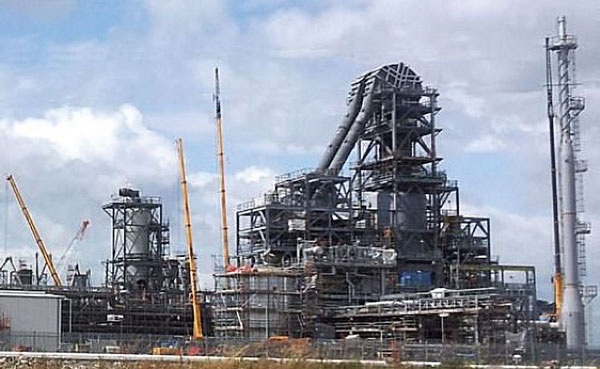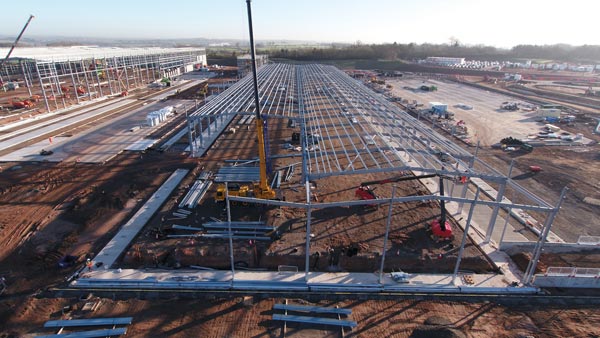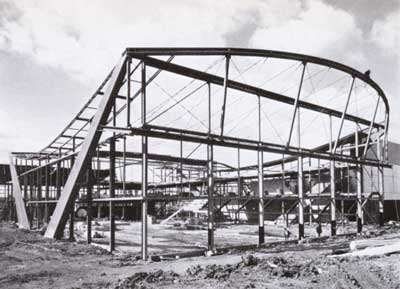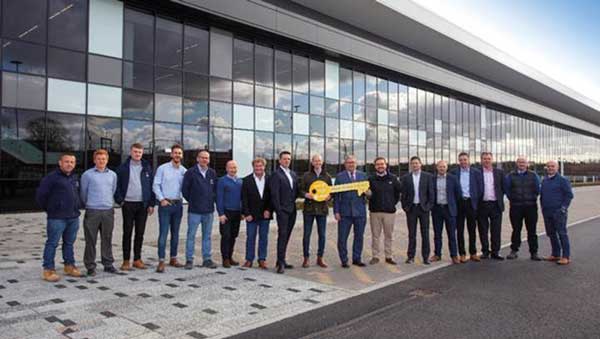SSDA Awards
Award – Splashpoint Leisure Centre, Worthing
 Including two swimming pools, a diving pool and a fitness centre, the Splashpoint Leisure Centre forms an important part in Worthing’s regeneration plans.
Including two swimming pools, a diving pool and a fitness centre, the Splashpoint Leisure Centre forms an important part in Worthing’s regeneration plans.
FACT FILE
Architect: Wilkinson Eyre Architects
Structural engineer: AECOM
Steelwork contractor: Severfield (UK)
Main contractor: Morgan Sindall
Client: Worthing Borough CouncilReplacing the ageing 1960s Aquarena swimming pool facility, the Splashpoint Leisure Centre has brought iconic architecture to a prime seafront location as part of Worthing’s ongoing redevelopment.
The building is 100% funded and operated by the Council, with the capital costs to be met by a future residential development to be built on an adjacent site. The project has achieved a BREEAM ‘Very Good’ rating and is designed to be sensitive to its coastal and town centre position.
Overall the structure is divided into two distinct parts, a two-storey structure housing changing rooms, shower cubicles and a fitness centre, and a large steel framed zone that contains all the swimming facilities.
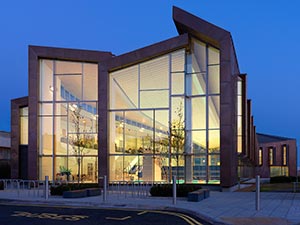
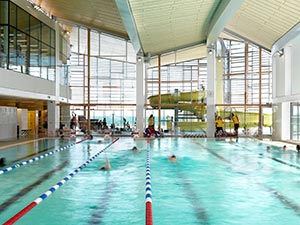
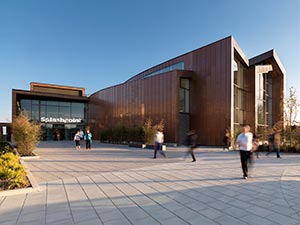 “Complex and irregular geometry combine with a mix of steel, timber and glass to create this sculpted and striking building on the seafront in Worthing,” says Chris Wilkinson, Founding Director, Wilkinson Eyre Architects.
“Complex and irregular geometry combine with a mix of steel, timber and glass to create this sculpted and striking building on the seafront in Worthing,” says Chris Wilkinson, Founding Director, Wilkinson Eyre Architects.
“The use of a steel frame for the pool hall was fundamental to achieving our architectural concept of a ‘light’ structure. The doubly curved, doubly asymmetric box-beams span over 50 metres and create a flowing roof profile reminiscent of ridges in blown sand on a beach.”
Splashpoint’s swimming facilities are divided into two zones, one 50m-long area containing a diving pool and a 25m–long swimming pool, and a smaller 30m-long area that contains a leisure pool.
Both of these swimming pool areas are spanned by a dramatic sawtooth roof, with its ranks of sinuous ridges, recalling a series of dunes that curve and twist towards the coast. This concept, which won a RIBA design competition at the project’s inception, has been recognised at a global level as the project was also declared winner of the World Architecture Festival 2013 Sports Category.
“The use of steel was fundamental to achieving the project’s architectural concept as the material is ideally suited to provide for the sculptured roof form and to create the 50m clear span for the main swimming pool area,” says Matthew Palmer, AECOM Regional Director – Structures.
“We also wanted to use a material that would give the project a ‘light’ feel to the structure, easily accommodate high level glazing and accept transparent façades that connect the pool to the sea.”
Steelwork provided a number of other benefits including a reduced on site programme and the avoidance of wet trades. It also helped the structure achieve the tight construction tolerances, which were essential for the interfaces with the glazing, cladding and importantly the timber roofing that required a 5mm installation tolerance.
Bracing had to be kept to a minimum within the steel frame, as it would have interfered with the large glazed areas.
Instead, the two main 50m-long box trapezoidal girders that span the pool take the loads from the western glazed façade through the profile of the roof and into the connecting two-storey structure.
Much of the steelwork within the pool area is exposed and as the environment is highly corrosive, a three-layer paint system with a 20-year life to first maintenance had to be used.
Externally, the copper and timber cladding was selected as it will gradually weather, setting the building into its surroundings
For the project’s main pool area roof high-grade stainless steel fixings have been used to support the timber roofing panels.
Coordination of the design was carried out using 3D models, with the architectural model, steelwork fabrication and timber fabrication models overlaid to help with early clash detection, which reduced costs and delays on site.
The fabricated structure, derived directly from the coordinated 3D model, fitted together perfectly on site. This was an impressive achievement, considering the complexity of the ridges, curves, steps and asymmetry of the structure.
Samples of each of the main beams were fabricated to provide quality benchmarks. The flush finish to shop and site welds provided the structure with clean, uninterrupted lines. Thorough geometric checks were made during the fabrication process to ensure that the complex geometry was formed correctly.
“We delivered steel to site in the largest possible pieces to cut down on the amount of on site work for what was a very technically challenging project,” says Steven Day, Severfield (UK) Deputy Managing Director.
For further ease of erection, site welding was limited to the mid-span of the two main roof beams by using bolted splices that reduced construction time while also improving site safety.
These doubly curved asymmetric beams are subject to biaxial bending, axial compression and torsion as the complex geometry gives rise to a range of imbalanced wind and snow loads.
Necessary analysis involved first principles checks, custom spreadsheets and finally a full non-linear finite element analysis of the entire structure to predict all of the forces and movements.
Moveable floors are fitted to both the diving and competition pools. These allow a full range of users to share the same space – swimming competitions, diving clubs, kids activities, water polo – and provide flexibility over the life of the building.
Judges’ Comment
The architect’s concept of a shaped roof swooping towards the sea has been well executed, with large plate-girder beams, tidy roof details and glazed façades. The team integrated its work well, and the building reflects this.
A highly successful building is helping to revitalise this part of the town, and the steel structure is a key element in its enormous popularity.









